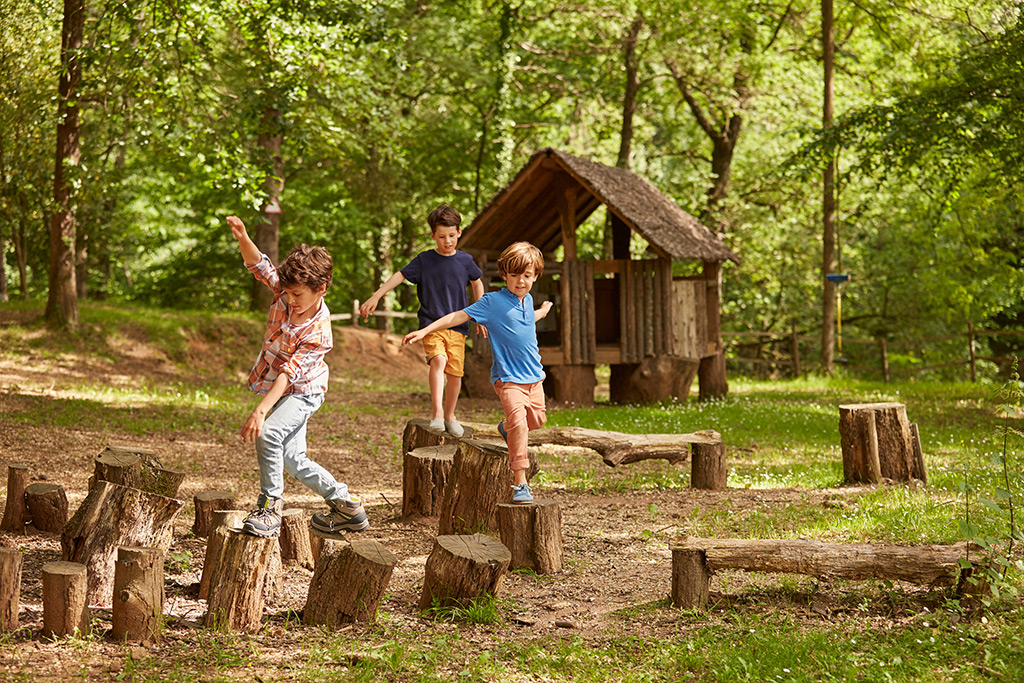Why Children Need Outdoor Risky Play

Previously published in Volume 81, Issue 4
In January 2015, I was invited to be part of a diverse group of professionals from across Canada, specializing in the fields of physical education, physical activity, and health. We were tasked with the responsibility of developing a national position statement on active outdoor play.
It was during these two days of meetings in Toronto when I realized the need to increase my own advocacy for outdoor play and learning, specifically with the Physical Education Teacher Education (PETE) students whom I teach at the University of Alberta.
I have always been an advocate for outdoor education, encouraging my own children, as well as my former students in grades 7-12, to go outside to play and learn. But after being immersed in the statistics showing how today’s Canadian children are ‘housebound’ and how parents are afraid to let their children go outside and play for fear of being abducted or risking injury, I felt an obligation to do what I could to make more of a difference.
So far, I’ve taken to social media to share the real facts about risky outdoor play, and I’ve made a concerted effort to increase the amount of time we discuss this topic in my PE methods/pedagogy courses.
What do we really know? What are we really scared of?
Have you or anyone you know ever complained about the air quality in a school or the school’s florescent lights having a negative effect on someone’s well being? In a 1989 USA study on indoor air quality, it was found that the average American spent 90% of his time indoors (U.S. Environmental Protection Agency). Unfortunately, studies have found that the air quality indoors is often far worse than the air we breathe outdoors, increasing our exposure to common allergens and infectious diseases, and potentially leading to chronic health conditions (Jones, 1991).
Canada is a country blessed with incredible nature and a bounty of outdoor recreational opportunities, but nature can be defined and understood differently by many people. The same can be said for the terms ‘risk’ and ‘risky play.’ Risk is often considered a negative, a bad word, instead of a term that in the context of play can simply mean a challenge or something that is exciting or thrilling. Parents, care providers and unfortunately many teachers and administrators have taken it upon themselves to create rules that stifle or eliminate outdoor play and the learning that results from it, for fear of what might happen to children when playing and experiencing the outdoors.
‘Bubble wrapping’ does more harm than good
Parents and teacher’s perceptions about danger can be disparate to actual danger. For example, while traffic concerns are borne out by statistics, child abductions by strangers are exceedingly rare. Ironically, ‘stranger danger’ concerns have resulted in increasing volumes of traffic, with corresponding increases in traffic-related dangers (Carver, Timperio, Crawford, 2008).
The terms ‘hyper-parenting’ and ‘bubble wrapping’ are recently coined terms reflecting the changing times. Instead of protecting children, though, research has found hyper-parenting actually limits physical activity and can harm a child’s mental health. In addition, when children are closely supervised in the outdoors by their parents or caregivers they are actually less active overall than if they are simply left alone to play and take risks (LeMoyne, Buchanan, 2011).
Risk and reward
As teachers, and specifically teachers of physical education, it can be tricky to give kids the opportunity to overcome risks and challenges through outdoor and adventurous activities when we live and work in a fear-based society. While none of us want children to be harmed, our fears can lead us to overreact to risky play. If we remove risk from play and ultimately from our pedagogy and purposeful planning, we are not encouraging nor allowing children to persist at challenging tasks. If we remove the challenges we are not developing resilience in our children. We need to recognize the difference between danger and risk and must value the long-term health and rewards as much as we value safety. If we do not change our perceptions and values as parents, teachers and caregivers then we run the risk of harming our children even more over the long haul.
The real risks of outdoor play
-
The odds of total stranger abduction of a child are about 1 in 14,000,000 based on RCMP reports. (Dalley, Ruscoe, 2003).
-
When children are outside they move more, sit less, and not surprisingly, play longer (Skala et al. 2012).
-
Broken bones and head injuries unfortunately do happen when children play, but major trauma is uncommon. Most injuries associated with outdoor play and learning in the outdoors are minor. (Nauta et al. 2015)
In fact, the risks associated with outdoor play in natural environments have proven to have positive effects for overall child development. Being able to climb, jump, tumble and explore independently not only increases physical health, but also helps to improve social interactions, creativity and resilience among kids.
So, if this much evidence points to such positivity and overall health and wellbeing benefits for children, then why are schools banning tag and preventing students from performing such things as cartwheels and round-offs during recess? Why are some Canadian cities and towns prohibiting tobogganing, skateboarding and other seasonal activities? Why do some teachers of physical education rarely, if ever, take their students outside for learning and recreational experiences such as hiking, cycling, geocaching and orienteering, over an entire term or semester? If the answer is fear or risk of injury or litigation, then again I ask these policy makers and leaders to consider the possible long-term harm of not allowing any of these experiences.
Natural playgrounds on the rise
While physical activity among children is a necessary facet of a healthy lifestyle, getting outside can make a world of difference. Playgrounds that feature a more natural environment such as hills, trees, rocks, grass and logs also have positive impacts on a child's health, behaviour and social development. Natural playgrounds also allow children to reconnect with nature itself, an opportunity that may be sorely missing from their daily routine as urban populations continue to swell. Natural playgrounds have begun popping up across the country as park designers, municipalities and school boards gravitate towards this form of organic recreation.
Vancouver, Edmonton and Moncton are among the Canadian cities to recently unveil natural playgrounds, complete with all-natural materials and no manufactured equipment. In Ontario, the city of Collingwood was the first municipality in the province to introduce a law banning plastic and steel playgrounds.
Children’s need for play has been internationally recognized as a basic right. Dozens of developmental and health benefits have also been linked to children’s need for outdoor risky play, as well as the need for a quality physical education program that values and implements learning in alternative environments.
Simple solutions and recommendations
-
All parents need to encourage their children to get outside more and fully embrace what the outdoors can offer. Parents also need to join their children in the outdoors and become stronger role models of embracing the elements and the opportunities that are unique to the outdoor environment.
-
Teachers and administrators need to step back and really reconsider what has been going on for the past number of years. They need to re-educate themselves with the real facts and realize they are doing more harm than good by disallowing so many activities and restricting play and programming that was not so restricted nor supervised only a generation ago.
-
Physical education teachers need to review their physical education year plans for all grades and ensure they have an appropriate number of classes with well-planned units and lessons that take advantage of outdoor learning. They need to remember all of the potential social, physical and emotional benefits that will be gained by all students when they are given the opportunity to be in unique outdoor learning environments.
If we want confident youth who are willing to embrace risk and challenge then we need confident teachers and parents who have a deep understanding of the issues surrounding risk and play, and this goes far beyond a narrow 'health and safety' agenda. By keeping our children indoors and protected we may actually be doing more harm than good to them, in the long run.
References
Carver, A., Timperio, A., & Crawford, D. Playing it safe: The influence of neighbourhood safety on Children’s physical activity – A review. Health Place (14), 217-227.
Dalley, M., Ruscoe, J. 2003. The abduction of children by strangers in Canada: Nature and scope. Royal Canadian Mounted Police.
Jones, AP. Asthma and domestic air quality. 1991. SocSci Med 47, 755-764.
LeMoyne, T., Buchanan, T. 2011. Does “hovering” matter? Helicopter parenting and its effect on well-being. Sociological Spectrum (31) 399-418.
Nauta, et al. Injury risk during different physical activity behaviours in children. A systematic review with bias assessment. Sport Med (45) 327-336.
Skala, et al. 2012. Environmental characteristics and student physical activity in PE class: findings from two large urban areas of Texas. Journal of Physical Activity and Health. Vol. 9, 481-491.
U.S. Environmental Protection Agency (EPA). 1989. Report to Congress on Indoor Air Quality – Vol. II: Assessment and Control of Indoor Air Pollution. EPA/400/1-89/001C. Washington, D.C.: US EPA. Available at www.tinyurl.com/CCN-2013-R017E.








